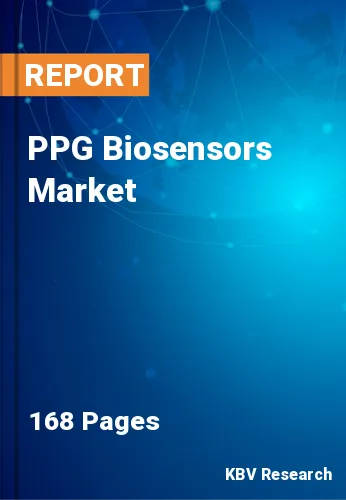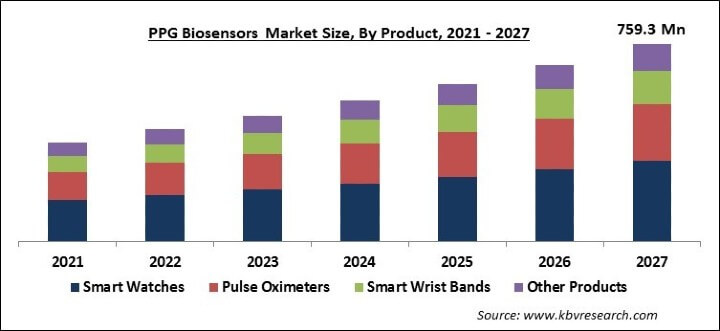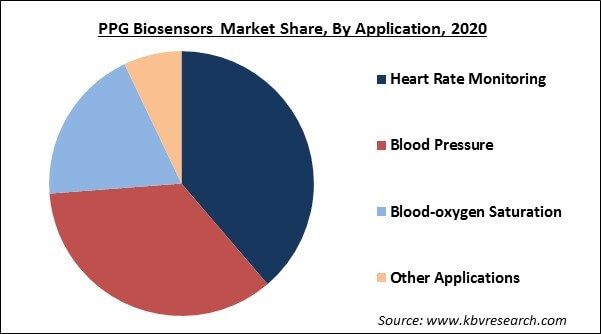
The Global PPG Biosensors Market size is expected to reach $759.3 Million by 2027, rising at a market growth of 12.2% CAGR during the forecast period. PPG refers to a simple and reasonable optical measurement procedure, which is utilized to monitor the heart rate of a person. It is a non-invasive technology, which utilizes a light source and a photodetector on the skin surface to calculate the volumetric variations of blood circulation. In recent years, there is an increasing focus from various researchers across the world on extracting more valuable data from the PPG signal apart from the heart rate estimation and pulse oximetry readings.
The increasing cases of cardiovascular diseases around the globe are supporting the growth of the PPG Biosensors market. There are many people across the globe who are suffering from some kind of cardiovascular disease, which requires continuous monitoring of the patient’s health condition. Thus, various healthcare systems or tools are used to monitor their heart rate and oxygen level to ensure their better health.

Heart-related diseases are one of the major reasons for increasing death cases around the world. So, portable, compact, and lightweight products are used to maintain a regular check of the patients. With the improvement in technologies, many companies have launched various smart gadgets that are helpful for the patient while adding up to the style statement.
The outbreak of the global COVID-19 pandemic has impacted every domain of society. Various regulations imposed during this pandemic have also affected almost every business sector. However, some sectors are also witnessing a positive impact on their growth. The pandemic has shown the significance of using digital technologies to monitor any patient remotely. There is a need for robust disease identification & monitoring that can be done by using wearable devices.
A COVID-19 patient suffers from certain symptoms like shortness of breath, fluctuations in heart rate, etc. In addition, it is important to check the heart rate and oxygen level of the covid-19 patients, which draw the attention of people towards the usage of wearable healthcare devices. These devices are embedded with PPG biosensors to measure heart rate, oxygen level, and many more, which would boost the growth of the PPG biosensors market during the forecast period.
Based on Product, the market is segmented into Smart Watches, Pulse Oximeters, Smart Wrist Bands and Other Products. By product, the smartwatches segment acquired the largest revenue share in the PPG biosensors market in 2020 and is anticipated to register a significant CAGR during the forecast period. There is increasing usage of PPG biosensors in consumer smartwatches that keep track of the user’s health conditions on daily basis during their sleep, sport, and other activities.

Based on Application, the market is segmented into Heart Rate Monitoring, Blood Pressure, Blood-oxygen Saturation and Other Applications. The blood-oxygen saturation market segment is estimated to acquire a significant CAGR during the forecast period. PPG refers to an optical technique for monitoring any fluctuation in blood flow. Pulse meter, which detects arterial Oxygen Saturation (SpO2) and is the most common usage of dual-wavelength PPG. Measuring the relative variations in haemoglobin level from the same PPG wavelengths, which are utilized to measure SpO2 and heart rates may be a very useful addition that increases the applications of PPG in the market.
| Report Attribute | Details |
|---|---|
| Market size value in 2020 | USD 332.8 Million |
| Market size forecast in 2027 | USD 759.3 Million |
| Base Year | 2020 |
| Historical Period | 2017 to 2019 |
| Forecast Period | 2021 to 2027 |
| Revenue Growth Rate | CAGR of 12.2% from 2021 to 2027 |
| Number of Pages | 168 |
| Number of Tables | 280 |
| Report coverage | Market Trends, Revenue Estimation and Forecast, Segmentation Analysis, Regional and Country Breakdown, Companies Strategic Developments, Company Profiling |
| Segments covered | Product, Application, Region |
| Country scope | US, Canada, Mexico, Germany, UK, France, Russia, Spain, Italy, China, Japan, India, South Korea, Singapore, Malaysia, Brazil, Argentina, UAE, Saudi Arabia, South Africa, Nigeria |
| Growth Drivers |
|
| Restraints |
|
Based on Regions, the market is segmented into North America, Europe, Asia Pacific, and Latin America, Middle East & Africa. Region-wise, North America emerged as the leading region in the PPG biosensors market in 2020 with the highest revenue share. The region is estimated to continue this trend during the forecast period. The increasing prevalence of cardiovascular diseases is one of the major factors driving the growth of the market.
Free Valuable Insights: Global PPG Biosensors Market size to reach USD 759.3 Million by 2027
The market research report covers the analysis of key stake holders of the market. Key companies profiled in the report include Texas Instruments, Inc., Vishay Intertechnology, Inc.., Renesas Electronics Corporation, AMS AG, Murata Manufacturing Co., Ltd., MediaTek, Inc., Maxim Integrated Products, Inc., Silicon Laboratories, Inc., Valencell, Inc., and LifeQ.
By Product
By Application
By Geography
The PPG biosensors market size is projected to reach USD 759.3 by 2027.
Increasing prevalence of cardiovascular diseases are driving the market in coming years, however, Slow commercialization of the PPG biosensors have limited the growth of the market.
Texas Instruments, Inc., Vishay Intertechnology, Inc.., Renesas Electronics Corporation, AMS AG, Murata Manufacturing Co., Ltd., MediaTek, Inc., Maxim Integrated Products, Inc., Silicon Laboratories, Inc., Valencell, Inc., and LifeQ.
It is important to check the heart rate and oxygen level of the covid-19 patients, Through wearable healthcare devices. These devices are embedded with PPG biosensors hence it boost the growth of the PPG biosensors market during the forecast period.
The skilled nursing services segment dominated the PPG biosensors market. It is accredited to the increasing number of children who are suffering from complex medical conditions like asthma, cerebral palsy, cystic fibrosis, and epilepsy.
Asia Pacific region is projected to showcase the fastest growth rate in the market during the forecast period and the North America market dominated the Global PPG Biosensors Market by Region in 2020.
Our team of dedicated experts can provide you with attractive expansion opportunities for your business.
